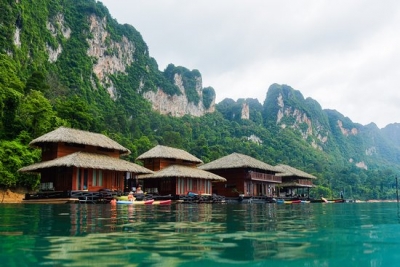
A lush green rainforest surrounded by towering limestone mountains and cliffs, the Khao Sok National Park was established in 1980. Located on the southern part of Thailand, this Park is spread across nearly 650 sq.km, and is dominated by spectacular waterfalls and caves. The Park is part of the Khlong Saeng-Khao Sok Forest Complex, the largest contiguous forest block in southern Thailand. A veritable fertile forest, it’s no surprise that the region boasts a variety of flora, which, in turn, supports many types of birds and mammals. However, the key attraction of the Park is a flower (see box)! It is the flower of Rafflesia kerrii, belonging to the Rafflesia family of plants.
Wildlife
Some of the birds that can be spotted here are hornbills, terns, herons, kingfishers, kites, eagles, hawks, waterhens, lapwings, sandpipers, pipits, pigeons, doves, parrots, coucals, malkohas, owls, trogons, bee-eaters, rollers, barbets, woodpeckers, broadbills, swifts, swallows, wagtails, leafbirds, bulbuls, drongos, babblers, munias, flowerpeckers, spiderhunters, sunbirds, flycatchers, thrushes, and robins. Among the many mammals that have made the Park their home are tiger, leopard, bear, the Malayan tapir, gaur, deer, wild boar, porcupine, macaque, gibbon, langur and the Asiatic wild dog. in addition to a large variety of reptiles and amphibians.
Rafflesia
- Rafflesia is a parasitic flowering plant and includes several species such as Rafflesia kerrii and Rafflesia amoldi. Rafflesia kerri is the symbolic flower of Surat Thani Province in which the Park is located
- The plant bears the largest flowers in the world – they can grow to have a diameter of more than three feet and weigh up to even 10 kg! Interestingly, the five-petalled flower is the only visible part of the plant
- The flower emits a foul smell that of rotting flesh- to attract insects such as flies, giving it its popular name “corpse flower”.
- These flowers are said to be in full bloom between October and December and are believed to have a very short life span. Rafflesia are threatened by habitat loss and human interference, among other factors.
Threats and concerns
Logging: More than 30 years ago, illegal logging was made unlawful in Thailand. The problem has been curtailed since then. However, it continues to this day in a few remote areas with the help of armed gangs. Also, it is important to note that logging is integral to people in some remote villagers, since it actually forms a basis of their income.
Plantations: Plantations, including rubber, cover large swathes of land. But then when demand for such plantation increases, it is possible that the areas expand to include natural forest environment, resulting in natural habitat loss. More and more loss of natural green cover means the chance of soil erosion too increases in these rainforests.
Poaching: Illegal wildlife trade is one of the causes for poaching in the region. Animals such as tigers constantly face this threat because their body parts are valued in traditional medicine in other countries such as China.
Tourism: Tourism can both be a blessing and a bane. Income generated by tourists keep national parks and wildlife sanctuaries going. They also help in the conservation of widlife. But unsustainable tourism can have an adverse impact on the habitat. Insensitive human behaviour towards wildlife, altering habitats to accommodate tourists, etc. add to human-related problems in natural wildlife habitats.
Picture Credit : Google




